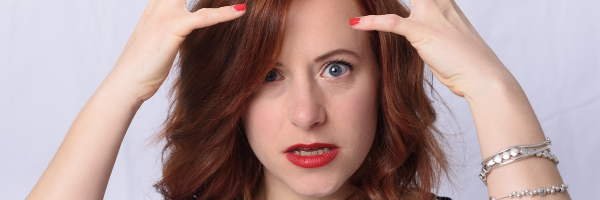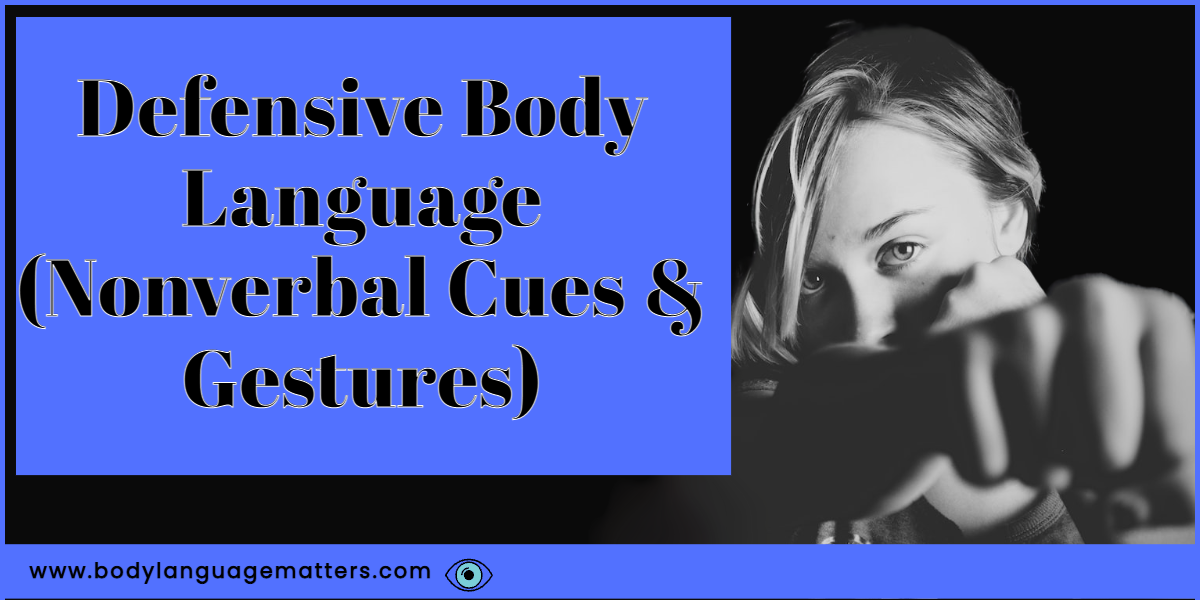There are many types of defensive body language gestures. You would have no doubt seen a few displayed by other people when they feel threatened or under attack. You may have seen these kinds of defensive nonverbal cues in the news or on YouTube before someone is about to be attacked physically or verbally. In this post, we will explore some of the most common defensive body language cues and how we can help people feel more comfortable.
The most common defensive body language is when someone crosses their arms in front of their chest. This is sometimes called a barrier or a way to protect vulnerable organs around the chest area. Most defensive non-verbals are done subconsciously, so it’s important to pay attention to them when noticed.
Defensive body language can be seen in many different situations, but it is most often seen when people are feeling threatened by something or someone. It can also happen when they feel like they are being criticized, judged, or blamed for something that they did not do.
To understand the body language of a person you’re talking to, first learn how to identify non-verbal prompts and cues. We will take a look at that next.
- How To Read Defensive Body Language
- Top 11 Defensive Body Language Cues.
- Averted gaze.
- Folded arms.
- Clenched fists.
- Tense muscles.
- Sweating.
- Increased heart rate.
- Shallow breathing.
- Tense jaw.
- Crossing of the arms.
- Crossing of the legs.
- Furrowing of the brows.
- Is Defensive Body Language A Sign Of Tension?
- What Does It Mean When A Person Is Defensive?
- What are defensive postures?
- How do you overcome defensive body language?
- Final Thoughts
How To Read Defensive Body Language

Reading body language is important to remember the context, environment, and conversation you see the non-verbal displayed. We then need to think about clusters of information around the defensive body language we have seen. For a more in-depth understanding on how to read body language check out How To Read Body Language & Nonverbal Cues (The Correct Way)
Context is always key to understanding what is happening, so it’s next on our list.
Context.
When thinking about context, we need to understand where they are, what time of day it is, and who they are in conversation with. Context is important because we need to build a picture first in order to start gathering data points in order to analyze the body language we are seeing.
Environment.
The environment we see the nonverbal displayed in will help give us clues to the body language we are seeing. For example, if we notice what we think is a defensive display of crossing the arms, outside this could simply mean they are cold and want to warm up with a self hug.
Conversation.
We need to take the conversation into account before analyzing. Are they discussing work history in an interview or are they talking to a spouse about something significant like being spotted with another person?
This data is extremely important when reading body language and should not be dismissed to find out more about how to read people.
Reading Clusters.
When someone is on the defensive, they will often make one or more of these gestures. When reading body language, we need to read clusters of information at a time. Single pieces of data will not give us the whole picture and could result in misinterpreting what is really being said.
Top Defensive Body Langauge Clusters.
- Cross their arms across their chest
- Touch their face or hair
- Mumble or clear their throat
- Gaze downwards
- Slump in posture
- Eye blocking
- Barriers
- Head down
- Taking up less space
- Leg’s crossed
- Fig leafing
If you see a few of the above non-verbals over the course of the conversation, then you can be confident that the person is feeling defensive about something, or threatened.
When it comes to defensive body language cues, there are some common ones we can look at.
Top 11 Defensive Body Language Cues.
Body language is context-dependent. it’s not possible to say if a person is a defensive based on one nonverbal piece of communication. There are certain rules in body language, though, that can help you decide: no single nonverbal cue can tell the whole story.
- Averted gaze.
- Folded arms.
- Clenched fists.
- Tense muscles.
- Sweating.
- Increased heart rate.
- Shallow breathing.
- Tense jaw.
- Crossing of the arms.
- Crossing of the legs.
- Furrowing of the brows.
Averted gaze.
An averted gaze is a form of defensive body language. It occurs when a person looks away from someone or something that they feel is threatening. An averted gaze can be a sign of fear, anxiety, or submission. It can also be used as a way to avoid eye contact and communication with others.
Folded arms.
Folded arms can indicate that someone is feeling defensive. They may be crossing their arms to create a physical barrier, or to signal that they are not open to communication. Folded arms can also be a way of self-comforting as if the person is holding themselves.
Clenched fists.
Clenched fists are often used in defensive body language, as they can be used to threaten or intimidate someone. They can also be used to show strength and power, as well as to show that someone is ready to fight.
Tense muscles.
Tense muscles in defensive body language usually mean that the person is feeling threatened or uncomfortable. This can be seen in things like tightened shoulders or a clenched jaw. It’s a way of protecting oneself from harm, both physically and emotionally.
Sweating.
Sweating can be a sign of defensive body language. It can indicate that a person is feeling anxious or stressed, and is trying to make themselves appear smaller and less threatening. If someone is sweating during a conversation, it may be a sign that they are uncomfortable or nervous about what is being discussed.
Increased heart rate.
An increased heart rate means that the person is feeling defensive. This is often seen in body language, where the person may have their arms crossed or they may be holding themselves tightly. This increase in heart rate can also be seen in the face, where the person may have a worried or concerned expression.
Shallow breathing.
Shallow breathing is a common sign of defensive body language. It can indicate that a person is feeling anxious or threatened and is preparing to defend themselves.
Tense jaw.
A tense jaw means that the person is feeling defensive and is preparing to fight. This is a common body language cue that is often seen in people who are feeling threatened or who are about to engage in physical violence.
Crossing of the arms.
Crossing of the arms is a defensive body language gesture in which the person’s arms are crossed over their chest. This gesture is often used to protect the person’s body from perceived threats.
Crossing of the legs.
Crossing of the legs is often seen as a defensive body language gesture, as it can be interpreted as a way of creating a physical barrier between the person and others. It can also be seen as a sign of discomfort or unease, as the person may be seeking to create some personal space.
Furrowing of the brows.
Furrowing of the brows is a defensive body language gesture in which the person’s eyebrows are drawn together, usually in a frown. This gesture is often used to express disbelief, scepticism, or disapproval. It can also be used as a way to make oneself appear more intimidating or to make a negative statement seem more forceful.
Is Defensive Body Language A Sign Of Tension?
We cannot judge a person’s emotions solely on the basis of body language. It is important to look at other signals as well. Tension can be misinterpreted as defensive body language because we will display a lot of the same signals or signs.
That’s why it’s important to not read someone without knowing their baseline first. To find out more about baselining check out this post. Sometimes people can have mixed feelings about something and some of these may show through in their body language. Understanding the context of an individual’s environment will give you important cues when reading them.
What Does It Mean When A Person Is Defensive?
When people are defensive, they are often looking out for themselves and their best interests. Defensiveness is a common defence mechanism that’s used when an individual is faced with criticism or feedback they don’t want to hear. It’s also a way of protecting oneself from the emotional pain of feeling offended or hurt by someone else’s words, actions, or intentions.
Defensive body language is when the person’s arms are crossed in front of their chest, their legs are crossed, or they are leaning away from you.
A boss using defensive body language around you could be a sign of one of three things:
1) They think that you’re not qualified for your job and want to put up some kind of barrier between themselves and you.
2) They might think that you’re doing something wrong at work and don’t want to get too close to avoid getting the blame.
3) They don’t know what to do in the situation they’re facing.
What are defensive postures?
Defensive postures are physical positions that help protect the body from harm. They can be used in response to real or perceived threats. Common defensive postures include curling up into a ball, raising one’s hands in surrender, or turning away from the threat.
How do you overcome defensive body language?
To help someone become more positive, you should try to overcome their defensive body language. This can be done by making yourself appear more approachable and open. Try to make eye contact, smile, and keep your body language relaxed. You can also try to start a conversation by asking questions or talking about something that interests them. If the person seems receptive, continue the conversation and see if you can build a rapport.
Final Thoughts
Defensive body language is a form of nonverbal communication in which someone tunes their body to take up less space and appear less threatening. There are many different ways people can do this, such as crossing their arms or closing their eyes or eye blocking, crossing the legs, physical barriers placing something in front of you and them, slower movement than normal, higher-pitched voice, and faster cadence than normal. These gestures can be classified as defensive body language signals. We hope you have learnt something from this post, thank you for taking the time to read, until next time.

